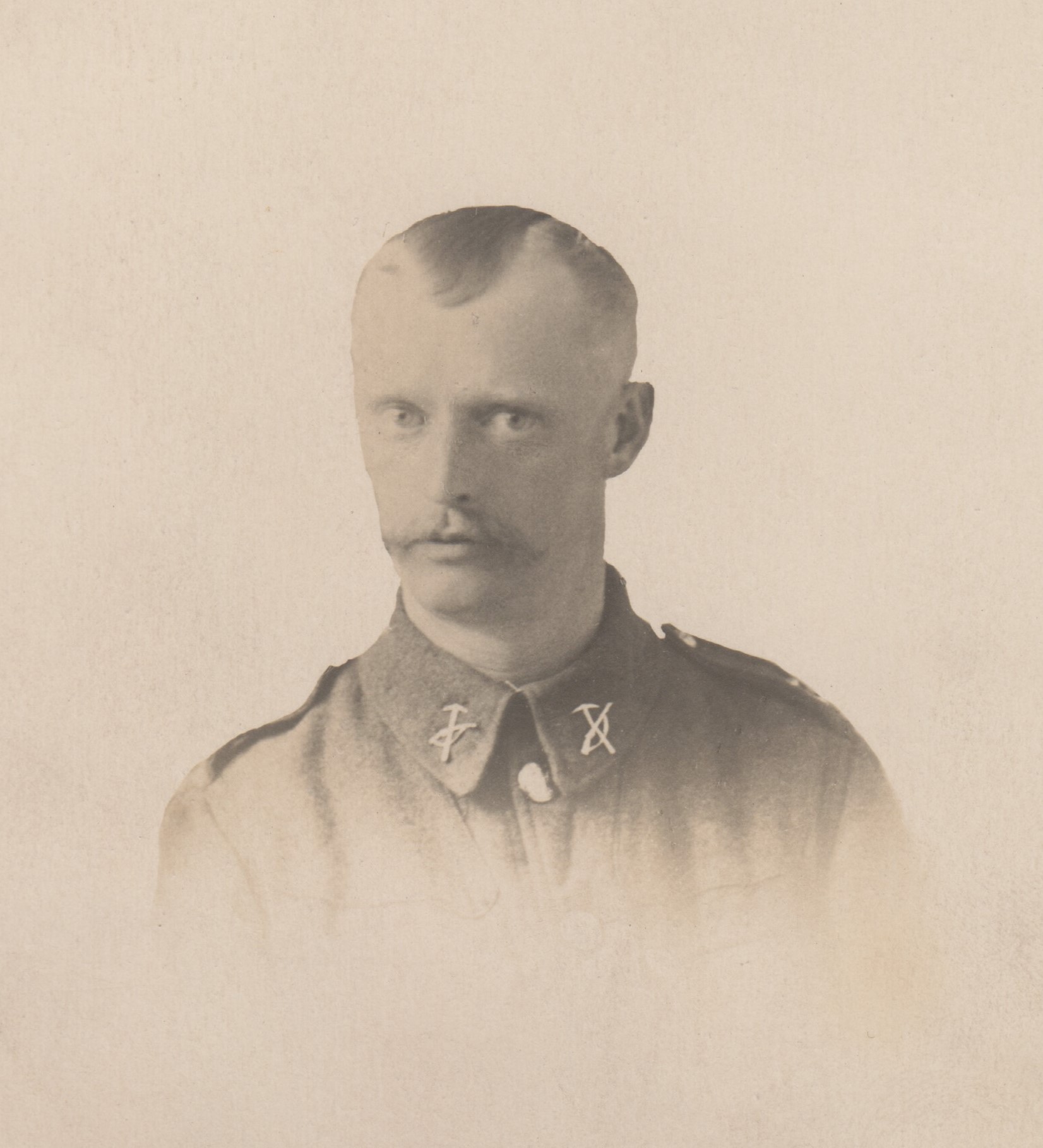
Edward was the Great Uncle of Robert Raw and Margaret Hird, who visited the museum during one of our Ribbon of Remembrance drop-in days.
Edward, born in Richmond (he lived for at time along Frenchgate and then at 3 Maison Dieu) worked as a plumber for the North Eastern Railway, and enlisted after the outbreak of war in York.
He became a Private in the 17th (Service) Battalion (NER Pioneers), a group whose skills were vital in constructing and maintaining the railways that developed behind the lines which kept the troops equiped and fed for the duration of the war. Edward was killed on 2nd November 1917, during the period where the battalion were working on light railways in the Ypres sector and suffered from shrapnel and gas shelling as well as high-explosives.
Edward Barker is buried in Bard Cottage Cemetery, Belgium.

Explore more memories from the ribbon
-
Arthur Godman
Arthur was born at Smeaton Hall , Great Smeaton, Northallerton, Yorkshire on the 9th September 1877. He was the son of Colonel A. F. Godman. He was educated at Rugby School and was commissioned 2nd Lieutenant, Yorkshire Regiment in May 1898. Whilst serving in India he wrote two articles for The Green Howrads Gazette. One was about ‘G’ Company’s donkey! Apparently awarded an Army Temperance Medal despite having a taste for alcohol! Advancing to Lieutenant in November 1900 he saw service in Somaliland. Promoted Captain in January 1906 and, after a posting in South Africa, returned to the UK to serve as Adjutant for the University of London Officer Training Corps. He was appointed Staff Captain attached to the 21st Infantry Brigade in 1914. Severely wounded at Ypres on the 30th October 1914, on recovery he was posted to the General Staff in France. Promoted Major in August 1915 he was attached to the 4th Brigade, Royal Flying Corps. He served as Brigade Major during the Battle of the Somme and advanced to Temporary Lieutenant Colonel, Assistant Adjutant General, on the RFC staff from July 1917. By the end of the war he was a Brigadier-General and was confirmed as a Wing Commander in August 1919. The following month he was posted as Assistant Commander, RAF Cranwell. He was posted to RAF HQ India at Simla being promoted to Group Captain in June 1923. Returning the following year to the UK he served consecutively as: Officer Commanding, School of Technical…
-
William McNally VC
William was born on the 16th December 1894 in the village of Murton in County Durham. At 14 he would follow his father down the pit at Mutton Colliery. At the outbreak of war he enlisted on the 3rd September, aged 20, into the Yorkshire Regiment, The Green Howards, and was posted to the 8th (Service) Battalion. The Battalion travelled to France in August 19115 as part of the 69th Brigade, 23rd Division. It was during the Somme offensive in 1916 that William would win his first Military medal, having gone out into no-man’s-land to rescue a wounded officer. The following year during 3rd Ypres, generally known as Passcheandaele, he received a bar to his Military Medal, again recuing men wounded or buried under shellfire. In late 1917 he was part of the detachment of British and French troops sent to the Italian front to bolster the Italians after their disastrous defeat at the Battle of Caparetto. In October of 1918 the allied advance culminated in their victory at the Battle of Vittorio Veneto paving the way for the total defeat of the Austrian Army. It was during this battle that William received the Victoria Cross having put to flight the enemy and capturing a machine gun. William left the Army in February 1919 and returned to life down the pit at Murton Colliery. He married and would father 6 children. In 1940 he joined the Local Defence Volunteers in Murton and the following year served in the Durham Home…
-
Thomas Tidyman
Information submitted by Lynne Pengelly. Thomas William Tidyman known as Bill (although this may have only been after he moved to Bradford) Born 1st November 1896 in Norton, Stockton on Tees the 2nd child, eldest son of John and Mary Tidyman The 1911 census shows him living and working on a farm in Agglethorpe (possibly Brecongill) with his parents and 6 siblings, his older sister is listed as a diarymaid. He enlisted on 24th May 1918 at the age of 23 into the 9th battalion of the Yorkshire Regiment and was wounded by a gunshot in his right forearm sometime in September 1918, he was transferred to the Bangour War hospital in Edinburgh and was discharged on 19th June 1919. Carl at the Green Howard’s museum was able to tell me that my grandad had been a marksman when he saw the badge on his uniform and also explained about the silver war badge given to injured men to wear after they had been discharged as unfit for further war service. After the war he returned to the farm his father died in 1920 and his mother died in 1927, at sometime he met my grandma who was visiting some friends who had relocated to Coverdale and they were married in Bradford on 7th December 1929. He was a tenant farmer at Harrop Edge Farm in Allerton Bradford until 1942 and then the family moved to Allerton village and he had a milk round. He worked for the War Ag…
